Cubism: Revolutionized Painting and Sculpture
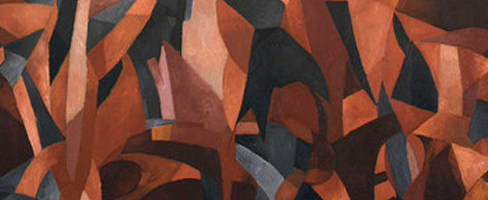
Cubism is an early-20th-century avant-garde art movement that revolutionized European painting and sculpture, and inspired related movements in music, literature and architecture. Cubism has been considered the most influential art movement of the 20th century. The term is broadly used in association with a wide variety of art produced in Paris (Montmartre, Montparnasse and Puteaux) during the 1910s and extending through the 1920s.
The movement was pioneered by Georges Braque and Pablo Picasso, joined by Jean Metzinger, Albert Gleizes, Robert Delaunay, Henri Le Fauconnier, Fernand Léger and Juan Gris. A primary influence that led to Cubism was the representation of three-dimensional form in the late works of Paul Cézanne. A retrospective of Cézanne’s paintings had been held at the Salon d’Automne of 1904, current works were displayed at the 1905 and 1906 Salon d’Automne, followed by two commemorative retrospectives after his death in 1907.
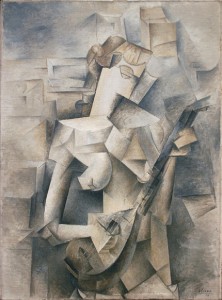
Pablo Picasso, 1910, Girl with a Mandolin (Fanny Tellier), oil on canvas, 100.3 x 73.6 cm, Museum of Modern Art, New York
In Cubist artwork, objects are analyzed, broken up and reassembled in an abstracted form—instead of depicting objects from one viewpoint, the artist depicts the subject from a multitude of viewpoints to represent the subject in a greater context.
The impact of Cubism was far-reaching and wide-ranging. Cubism spread rapidly across the globe and in doing so evolved to greater or lesser extent. In essence, Cubism was the starting point of an evolutionary process that produced diversity; it was the antecedent of diverse art movements.
In France, offshoots of Cubism developed, including Orphism, Abstract art and later Purism. In other countries Futurism, Suprematism, Dada, Constructivism and De Stijl developed in response to Cubism. Early Futurist paintings hold in common with Cubism the fusing of the past and the present, the representation of different views of the subject pictured at the same time, also called multiple perspective, simultaneity or multiplicity, while Constructivism was influenced by Picasso’s technique of constructing sculpture from separate elements. Other common threads between these disparate movements include the faceting or simplification of geometric forms, and the association of mechanization and modern life.
Conception and origins
Cubism began between 1907 and 1911. Pablo Picasso’s 1907 painting Les Demoiselles d’Avignon has often been considered a proto-Cubist work. Georges Braque’s 1908 Houses at L’Estaque (and related works) prompted the critic Louis Vauxcelles to refer to bizarreries cubiques (cubic oddities). Gertrude Stein referred to landscapes made by Picasso in 1909, such as Reservoir at Horta de Ebro, as the first Cubist paintings. The first organized group exhibition by Cubists took place at the Salon des Indépendants in Paris during the spring of 1911 in a room called ‘Salle 41’; it included works by Jean Metzinger, Albert Gleizes, Fernand Léger, Robert Delaunay and Henri Le Fauconnier, yet no works by Picasso and Braque were exhibited.
By 1911 Picasso was recognized as the inventor of Cubism, while Braque’s importance and precedence was argued later, with respect to his treatment of space, volume and mass in the L’Estaque landscapes. But “this view of Cubism is associated with a distinctly restrictive definition of which artists are properly to be called Cubists,” wrote the art historian Christopher Green: “Marginalizing the contribution of the artists who exhibited at the Salon des Indépendants in 1911.
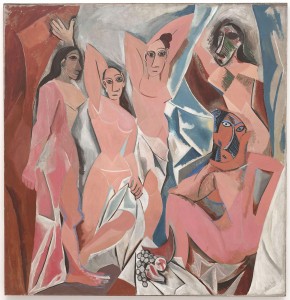
Pablo Picasso, Les Demoiselles d’Avignon, 1907, considered to be a major step towards the founding of the Cubist movement.
Historians have divided the history of Cubism into phases. In one scheme, the first phase of Cubism, known as Analytic Cubism, a phrase coined by Juan Gris a posteriori, was both radical and influential as a short but highly significant art movement between 1910 and 1912 in France. A second phase, Synthetic Cubism, remained vital until around 1919, when the Surrealist movement gained popularity. English art historian Douglas Cooper proposed another scheme, describing three phases of Cubism in his book, The Cubist Epoch. According to Cooper there was “Early Cubism”, (from 1906 to 1908) when the movement was initially developed in the studios of Picasso and Braque; the second phase being called “High Cubism”, (from 1909 to 1914) during which time Juan Gris emerged as an important exponent (after 1911); and finally Cooper referred to “Late Cubism” (from 1914 to 1921) as the last phase of Cubism as a radical avant-garde movement. Douglas Cooper’s restrictive use of these terms to distinguish the work of Braque, Picasso, Gris (from 1911) and Léger (to a lesser extent) implied an intentional value judgement.
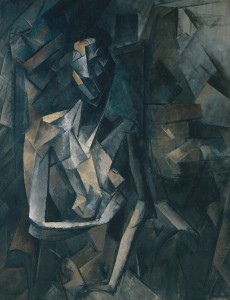
Pablo Picasso, 1909-10, Figure dans un Fauteuil (Seated Nude, Femme nue assise), oil on canvas, 92.1 x 73 cm, Tate Modern, London
The assertion that the Cubist depiction of space, mass, time, and volume supports (rather than contradicts) the flatness of the canvas was made by Daniel-Henry Kahnweiler as early as 1920, but it was subject to criticism in the 1950s and 1960s, especially by Clement Greenberg. Contemporary views of Cubism are complex, formed to some extent in response to the “Salle 41” Cubists, whose methods were too distinct from those of Picasso and Braque to be considered merely secondary to them. Alternative interpretations of Cubism have therefore developed. Wider views of Cubism include artists who were later associated with the “Salle 41” artists, e.g., Francis Picabia; the brothers Jacques Villon, Raymond Duchamp-Villon and Marcel Duchamp, who beginning in late 1911 formed the core of the Section d’Or (or the Puteaux Group); the sculptors Alexander Archipenko, Joseph Csaky and Ossip Zadkine as well as Jacques Lipchitz and Henri Laurens; and painters such as Louis Marcoussis, Roger de La Fresnaye, František Kupka, Diego Rivera, Léopold Survage, Auguste Herbin, André Lhote, Gino Severini (after 1916), María Blanchard (after 1916) and Georges Valmier (after 1918). More fundamentally, Christopher Green argues that Douglas Cooper’s terms were “later undermined by interpretations of the work of Picasso, Braque, Gris and Léger that stress iconographic and ideological questions rather than methods of representation.”
John Berger identifies the essence of Cubism with the mechanical diagram. “The metaphorical model of Cubism is the diagram: The diagram being a visible symbolic representation of invisible processes, forces, structures. A diagram need not eschew certain aspects of appearance but these too will be treated as signs not as imitations or recreations.”
Technical and stylistic aspects
During the late 19th and early 20th centuries, Europeans were discovering African, Polynesian, Micronesian and Native American art. Artists such as Paul Gauguin, Henri Matisse, and Pablo Picasso were intrigued and inspired by the stark power and simplicity of styles of those foreign cultures. Around 1906, Picasso met Matisse through Gertrude Stein, at a time when both artists had recently acquired an interest in primitivism, Iberian sculpture, African art and African tribal masks. They became friendly rivals and competed with each other throughout their careers, perhaps leading to Picasso entering a new period in his work by 1907, marked by the influence of Greek, Iberian and African art. Picasso’s paintings of 1907 have been characterized as Protocubism, as notably seen in Les Demoiselles d’Avignon, the antecedent of Cubism.
The art historian Douglas Cooper states that Paul Gauguin and Paul Cézanne “were particularly influential to the formation of Cubism and especially important to the paintings of Picasso during 1906 and 1907”. Cooper goes on to say: “The Demoiselles is generally referred to as the first Cubist picture. This is an exaggeration, for although it was a major first step towards Cubism it is not yet Cubist. The disruptive, expressionist element in it is even contrary to the spirit of Cubism, which looked at the world in a detached, realistic spirit. Nevertheless, the Demoiselles is the logical picture to take as the starting point for Cubism, because it marks the birth of a new pictorial idiom, because in it Picasso violently overturned established conventions and because all that followed grew out of it.”
The most serious objection to regarding the Demoiselles as the origin of Cubism, with its evident influence of primitive art, is that “such deductions are unhistorical”, wrote the art historian Daniel Robbins. This familiar explanation “fails to give adequate consideration to the complexities of a flourishing art that existed just before and during the period when Picasso’s new painting developed.” Between 1905 and 1908, a conscious search for a new style caused rapid changes in art across France, Germany, Holland, Italy, and Russia. The Impressionists had used a double point of view, and both Les Nabis and the Symbolists (who also admired Cézanne) flattened the picture plane, reducing their subjects to simple geometric forms. Neo-Impressionist structure and subject matter, most notably to be seen in the works of Georges Seurat (e.g., Parade de Cirque, Le Chahut and Le Cirque), was another important influence. There were also parallels in the development of literature and social thought.
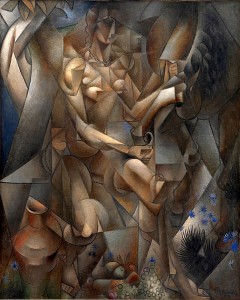
Jean Metzinger, La Femme au Cheval, Woman with a horse, 1911-1912, Statens Museum for Kunst, National Gallery of Denmark. Exhibited at the 1912 Salon des Indépendants, and published in Apollinaire’s 1913 The Cubist Painters, Aesthetic Meditations. Provenance: Jacques Nayral, Niels Bohr
In addition to Seurat, the roots of cubism are to be found in the two distinct tendencies of Cézanne’s later work: first his breaking of the painted surface into small multifaceted areas of paint, thereby emphasizing the plural viewpoint given by binocular vision, and second his interest in the simplification of natural forms into cylinders, spheres, and cones. However, the cubists explored this concept further than Cézanne. They represented all the surfaces of depicted objects in a single picture plane, as if the objects had all their faces visible at the same time. This new kind of depiction revolutionized the way objects could be visualized in painting and art.
Jean Metzinger, La Femme au Cheval, Woman with a horse, 1911-1912, Statens Museum for Kunst, National Gallery of Denmark. Exhibited at the 1912 Salon des Indépendants, and published in Apollinaire’s 1913 The Cubist Painters, Aesthetic Meditations. Provenance: Jacques Nayral, Niels Bohr
The historical study of Cubism began in the late 1920s, drawing at first from sources of limited data, namely the opinions of Guillaume Apollinaire. It came to rely heavily on Daniel-Henry Kahnweiler’s book Der Weg zum Kubismus (published in 1920), which centered on the developments of Picasso, Braque, Léger, and Gris. The terms “analytical” and “synthetic” which subsequently emerged have been widely accepted since the mid-1930s. Both terms are historical impositions that occurred after the facts they identify. Neither phase was designated as such at the time corresponding works were created. “If Kahnweiler considers Cubism as Picasso and Braque,” wrote Daniel Robbins, “our only fault is in subjecting other Cubists’ works to the rigors of that limited definition.”
The traditional interpretation of “Cubism”, formulated post facto as a means of understanding the works of Braque and Picasso, has affected our appreciation of other twentieth-century artists. It is difficult to apply to painters such as Jean Metzinger, Albert Gleizes, Robert Delaunay and Henri Le Fauconnier, whose fundamental differences from traditional Cubism compelled Kahnweiler to question their right to be called Cubists at all. According to Daniel Robbins, “To suggest that merely because these artists developed differently or varied from the traditional pattern they deserved to be relegated to a secondary or satellite role in Cubism is a profound mistake.”
The history of the term “Cubism” usually stresses the fact that Matisse referred to “cubes” in connection with a painting by Braque in 1908, and that the term was published twice by the critic Louis Vauxcelles in a similar context. However, the word “cube” was used in 1906 by another critic, Louis Chassevent, with reference not to Picasso or Braque but rather to Metzinger and Delaunay:
“M. Metzinger is a mosaicist like M. Signac but he brings more precision to the cutting of his cubes of color which appear to have been made mechanically.
The critical use of the word “cube” goes back at least to May 1901 when Jean Béral, reviewing the work of Henri-Edmond Cross at the Indépendants in Art et Littérature, commented that he “uses a large and square pointillism, giving the impression of mosaic. One even wonders why the artist has not used cubes of solid matter diversely colored: they would make pretty revetments.” (Robert Herbert, 1968, p. 221)
The term Cubism did not come into general usage until 1911, mainly with reference to Metzinger, Gleizes, Delaunay, and Léger. In 1911, the poet and critic Guillaume Apollinaire accepted the term on behalf of a group of artists invited to exhibit at the Brussels Indépendants. The following year, in preparation for the Salon de la Section d’Or, Metzinger and Gleizes wrote and published Du “Cubisme” in an effort to dispel the confusion raging around the word, and as a major defence of Cubism (which had caused a public scandal following the 1911 Salon des Indépendants and the 1912 Salon d’Automne in Paris). Clarifying their aims as artists, this work was the first theoretical treatise on Cubism and it still remains the clearest and most intelligible. The result, not solely a collaboration between its two authors, reflected discussions by the circle of artists who met in Puteaux and Courbevoie. It mirrored the attitudes of the “artists of Passy”, which included Picabia and the Duchamp brothers, to whom sections of it were read prior to publication. The concept developed in Du “Cubisme” of observing a subject from different points in space and time simultaneously, i.e., the act of moving around an object to seize it from several successive angles fused into a single image (multiple viewpoints, mobile perspective, simultaneity or multiplicity), is a generally recognized device used by the Cubists.
The 1912 manifetso Du “Cubisme” by Metzinger and Gleizes was followed in 1913 by Les Peintres Cubistes, a collection of reflections and commentaries by Guillaume Apollinaire. Apollinaire had been closely involved with Picasso beginning in 1905, and Braque beginning in 1907, but gave as much attention to artists such as Metzinger, Gleizes, Delaunay, Picabia, and Duchamp.
Cubism before 1914
There was a distinct difference between Kahnweiler’s Cubists and the Salon Cubists. Prior to 1914, Picasso, Braque, Gris and Léger (to a lesser extent) gained the support of a single committed art dealer in Paris, Daniel-Henry Kahnweiler, who guaranteed them an annual income for the exclusive right to buy their works. Kahnweiler sold only to a small circle of connoisseurs. His support gave his artists the freedom to experiment in relative privacy. Picasso worked in Montmartre until 1912, while Braque and Gris remained there until after the First World War. Léger was based in Montparnasse.
In contrast, the Salon Cubists built their reputation primarily by exhibiting regularly at the Salon d’Automne and the Salon des Indépendants, both major non-academic Salons in Paris. They were inevitably more aware of public response and the need to communicate. Already in 1910 a group began to form which included Metzinger, Gleizes, Delaunay and Léger. They met regularly at Henri le Fauconnier’s studio near the Boulevard de Montparnasse. These soirées often included writers such as Guillaume Apollinaire and André Salmon. Together with other young artists, the group wanted to emphasise a research into form, in opposition to the Neo-Impressionist emphasis on color.
Louis Vauxcelles, in his review of the 26th Salon des Indépendants (1910), made a passing and imprecise reference to Metzinger, Gleizes, Delaunay, Léger and Le Fauconnier as “ignorant geometers, reducing the human body, the site, to pallid cubes.”At the 1910 Salon d’Automne, a few months later, Metzinger exhibited his highly fractured Nu à la cheminée (Nude), which was subsequently reproduced in Les Peintres Cubistes by Apollinaire (1913).
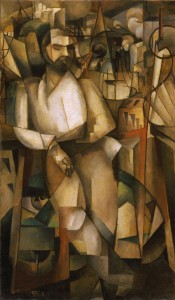
Albert Gleizes, L’Homme au Balcon, Man on a Balcony (Portrait of Dr. Théo Morinaud), 1912, oil on canvas, 195.6 x 114.9 cm (77 x 45 1/4 in.), Philadelphia Museum of Art. Completed the same year that Albert Gleizes co-authored the book Du “Cubisme” with Jean Metzinger. Exhibited at Salon d’Automne, Paris, 1912, Armory show, New York, Chicago, Boston, 1913
The first public controversy generated by Cubism resulted from Salon showings at the Indépendants during the spring of 1911. This showing by Metzinger, Gleizes, Delaunay, le Fauconnier and Léger brought Cubism to the attention of the general public for the first time. Amongst the Cubist works presented, Robert Delaunay exhibited his Eiffel Tower, Tour Eiffel (Solomon R. Guggenheim Museum, New York).
The “Cubists” Dominate Paris’ Fall Salon, The New York Times, October 8, 1911. Picasso’s 1908 Seated Woman (Meditation) is reproduced along with a photograph of the artist in his studio (upper left). Metzinger’s Baigneuses (1908-09) is reproduced top right. Also reproduced are works by Derain, Matisse, Friesz, Herbin, and a photo of Braque
At the Salon d’Automne of the same year, in addition to the Indépendants group of Salle 41, were exhibited works by André Lhote, Marcel Duchamp, Jacques Villon, Roger de La Fresnaye, André Dunoyer de Segonzac and František Kupka. The exhibition was reviewed in the October 8, 1911 issue of The New York Times. This article was published a year after Gelett Burgess’ The Wild Men of Paris, and two years prior to the Armory Show, which introduced astonished Americans, accustomed to realistic art, to the experimental styles of the European avant garde, including Fauvism, Cubism, and Futurism. The 1911 New York Times article portrayed works by Picasso, Matisse, Derain, Metzinger and others dated before 1909; not exhibited at the 1911 Salon. The article was titled The “Cubists” Dominate Paris’ Fall Salon and subtitled Eccentric School of Painting Increases Its Vogue in the Current Art Exhibition – What Its Followers Attempt to Do.
“Among all the paintings on exhibition at the Paris Fall Salon none is attracting so much attention as the extraordinary productions of the so-called “Cubist” school. In fact, dispatches from Paris suggest that these works are easily the main feature of the exhibition.
In spite of the crazy nature of the “Cubist” theories the number of those professing them is fairly respectable. Georges Braque, André Derain, Picasso, Czobel, Othon Friesz, Herbin, Metzinger—these are a few of the names signed to canvases before which Paris has stood and now again stands in blank amazement.
What do they mean? Have those responsible for them taken leave of their senses? Is it art or madness? Who knows?”
The subsequent 1912 Salon des Indépendants was marked by the presentation of Marcel Duchamp’s Nude Descending a Staircase, No. 2, which itself caused a scandal, even amongst the Cubists. It was in fact rejected by the hanging committee, which included his brothers and other Cubists. Although the work was shown in the Salon de la Section d’Or in October 1912 and the 1913 Armory Show in New York, Duchamp never forgave his brothers and former colleagues for censoring his work. Juan Gris, a new addition to the Salon scene, exhibited his Portrait of Picasso (Art Institute of Chicago), while Metzinger’s two showings included La Femme au Cheval (Woman with a horse) 1911-1912 (Statens Museum for Kunst, National Gallery of Denmark). Delaunay’s monumental La Ville de Paris (Musée d’art moderne de la Ville de Paris) and Léger’s La Noce, The Wedding (Musée National d’Art Moderne, Paris) were also exhibited.
The Cubist contribution to the 1912 Salon d’Automne created scandal regarding the use of government owned buildings, such as the Grand Palais, to exhibit such artwork. The indignation of the politician Jean Pierre Philippe Lampué made the front page of Le Journal, 5 October 1912. The controversy spread to the Municipal Council of Paris, leading to a debate in the Chambre des Députés about the use of public funds to provide the venue for such art. The Cubists were defended by the Socialist deputy, Marcel Sembat.
It was against this background of public anger that Jean Metzinger and Albert Gleizes wrote Du “Cubisme” (published by Eugène Figuière in 1912, translated to English and Russian in 1913). Among the works exhibited were Le Fauconnier’s vast composition Les Montagnards attaqués par des ours (Mountaineers Attacked by Bears) now at Rhode Island School of Design Museum, Joseph Csaky’s Deux Femme, Two Women (a sculpture now lost), in addition to the highly abstract paintings by Kupka, Amorpha (The National Gallery, Prague), and Picabia, La Source, The Spring (Museum of Modern Art, New York).
Abstraction and the Ready-made
The most extreme forms of Cubism were not those practiced by Picasso and Braque, who resisted total abstraction. Other Cubists, by contrast, especially František Kupka, and those considered Orphists by Apollinaire (Delaunay, Léger, Picabia and Duchamp), accepted abstraction by removing visible subject matter entirely. Kupka’s two entries at the 1912 Salon d’Automne, Amorpha-Fugue à deux couleurs and Amorpha chromatique chaude, were highly abstract (or nonrepresentational) and metaphysical in orientation. Both Duchamp in 1912 and Picabia from 1912 to 1914 developed an expressive and allusive abstraction dedicated to complex emotional and sexual themes.
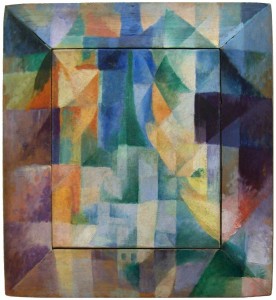
Robert Delaunay, Simultaneous Windows on the City, 1912, 46 x 40 cm, Hamburger Kunsthalle, an example of Abstract Cubism
Beginning in 1912 Delaunay painted a series of paintings entitled Simultaneous Windows, followed by a series entitled Formes Circulaires, in which he combined planar structures with bright prismatic hues; based on the optical characteristics of juxtaposed colors his departure from reality in the depiction of imagery was quasi-complete. In 1913–14 Léger produced a series entitled Contrasts of Forms, giving a similar stress to color, line and form. His Cubism, despite its abstract qualities, was associated with themes of mechanization and modern life. Apollinaire supported these early developments of abstract Cubism in Les Peintres cubistes (1913), writing of a new “pure” painting in which the subject was vacated. But in spite of his use of the term Orphism these works were so different that they defy attempts to place them in a single category.
Also labeled an Orphist by Apollinaire, Marcel Duchamp was responsible for another extreme development inspired by Cubism. The Ready-made arose from a joint consideration that the work itself is considered an object (just as a painting), and that it uses the material detritus of the world (as collage and papier collé in the Cubist construction and Assemblage). The next logical step, for Duchamp, was to present an ordinary object as a self-sufficient work of art representing only itself. In 1913 he attached a bicycle wheel to a kitchen stool and in 1914 selected a bottle-drying rack as a sculpture in its own right.
Section d’Or
The Section d’Or, also known as Groupe de Puteaux, founded by some of the most conspicuous Cubists, was a collective of painters, sculptors and critics associated with Cubism and Orphism, active from 1911 through about 1914, coming to prominence in the wake of their controversial showing at the 1911 Salon des Indépendants. The Salon de la Section d’Or at the Galerie La Boétie in Paris, October 1912, was arguably the most important pre-World War I Cubist exhibition; exposing Cubism to a wide audience. Over 200 works were displayed, and the fact that many of the artists showed artworks representative of their development from 1909 to 1912 gave the exhibition the allure of a Cubist retrospective.
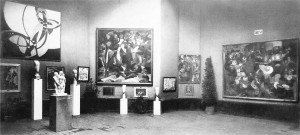
The Salon d’Automne of 1912, held in Paris at the Grand Palais from 1 October to 8 November. Joseph Csaky’s sculpture Groupe de femmes of 1911-12 is exhibited to the left, in front of two sculptures by Amedeo Modigliani. Other works by Section d’Or artists are shown (left to right): František Kupka, Francis Picabia, Jean Metzinger and Henri Le Fauconnier
The group seems to have adopted the name Section d’Or to distinguish themselves from the narrower definition of Cubism developed in parallel by Pablo Picasso and Georges Braque in the Montmartre quarter of Paris, and to show that Cubism, rather than being an isolated art-form, represented the continuation of a grand tradition (indeed, the golden ratio had fascinated Western intellectuals of diverse interests for at least 2,400 years).
The idea of the Section d’Or originated in the course of conversations between Metzinger, Gleizes and Jacques Villon. The group’s title was suggested by Villon, after reading a 1910 translation of Leonardo da Vinci’s Trattato della Pittura by Joséphin Péladan.
The fact that the 1912 exhibition had been curated to show the successive stages through which Cubism had transited, and that Du “Cubisme” had been published for the occasion, indicates the artists’ intention of making their work comprehensible to a wide audience (art critics, art collectors, art dealers and the general public). Undoubtedly, due to the great success of the exhibition, Cubism became recognized as a tendency, genre or style in art with a specific common philosophy or goal: a new avant-garde movement.
Intentions and interpretations
The Cubism of Picasso, Braque and Gris had more than a technical or formal significance, and the distinct attitudes and intentions of the Salon Cubists produced different kinds of Cubism, rather than a derivative of their work. “It is by no means clear, in any case,” wrote Christopher Green, “to what extent these other Cubists depended on Picasso and Braque for their development of such techniques as faceting, ‘passage’ and multiple perspective; they could well have arrived at such practices with little knowledge of ‘true’ Cubism in its early stages, guided above all by their own understanding of Cézanne.” The works exhibited by these Cubists at the 1911 and 1912 Salons extended beyond the conventional Cézanne-like subjects—the posed model, still-life and landscape—favored by Picasso and Braque to include large-scale modern-life subjects. Aimed at a large public, these works stressed the use of multiple perspective and complex planar faceting for expressive effect while preserving the eloquence of subjects endowed with literary and philosophical connotations.
In Du “Cubisme” Metzinger and Gleizes explicitly related the sense of time to multiple perspective, giving symbolic expression to the notion of ‘duration’ proposed by the philosopher Henri Bergson according to which life is subjectively experienced as a continuum, with the past flowing into the present and the present merging into the future. The Salon Cubists used the faceted treatment of solid and space and effects of multiple viewpoints to convey a physical and psychological sense of the fluidity of consciousness, blurring the distinctions between past, present and future. One of the major theoretical innovations made by the Salon Cubists, independently of Picasso and Braque, was that of simultaneity, drawing to greater or lesser extent on theories of Henri Poincaré, Ernst Mach, Charles Henry, Maurice Princet, and Henri Bergson. With simultaneity, the concept of separate spatial and temporal dimensions was comprehensively challenged. Linear perspective developed during the Renaissance was vacated. The subject matter was no longer considered from a specific point of view at a moment in time, but built following a selection of successive viewpoints, i.e., as if viewed simultaneously from numerous angles (and in multiple dimensions) with the eye free to roam from one to the other.
This technique of representing simultaneity, multiple viewpoints (or relative motion) is pushed to a high degree of complexity in Gleizes’ monumental Le Dépiquage des Moissons (Harvest Threshing), exhibited at the 1912 Salon de la Section d’Or, Le Fauconnier’s Abundance shown at the Indépendants of 1911, and Delaunay’s City of Paris, shown at the Indépendants in 1912. These ambitious works are some of the largest paintings in the history of Cubism. Léger’s The Wedding, also shown at the Salon des Indépendants in 1912, gave form to the notion of simultaneity by presenting different motifs as occurring within a single temporal frame, where responses to the past and present interpenetrate with collective force. The conjunction of such subject matter with simultaneity aligns Salon Cubism with early Futurist paintings by Umberto Boccioni, Gino Severini and Carlo Carrà; themselves made in response to early Cubism.
Cubism and modern European art was introduced into the United States at the now legendary 1913 Armory Show in New York City, which then traveled to Chicago and Boston. In the Armory show Pablo Picasso exhibited La Femme au pot de moutarde (1910), the sculpture Head of a Woman (Fernande) (1909–10), Les Arbres (1907) amongst other cubist works. Jacques Villon exhibited seven important and large drypoints, his brother Marcel Duchamp shocked the American public with his painting Nude Descending a Staircase, No. 2 (1912). Francis Picabia exhibited his abstractions La Danse à la source and La Procession, Seville (both of 1912). Albert Gleizes exhibited La Femme aux phlox (1910) and L’Homme au balcon (1912), two highly stylized and faceted cubist works. Georges Braque, Fernand Léger, Raymond Duchamp-Villon, Roger de La Fresnaye and Alexander Archipenko also contributed examples of their cubist works.
Cubist sculpture
Just as in painting, Cubist sculpture is rooted in Paul Cézanne’s reduction of painted objects into component planes and geometric solids (cubes, spheres, cylinders, and cones). And just as in painting, it became a pervasive influence and contributed fundamentally to Constructivism and Futurism.
Cubist sculpture developed in parallel to Cubist painting. During the autumn of 1909 Picasso sculpted Head of a Woman (Fernande) with positive features depicted by negative space and vice versa. According to Douglas Cooper: “The first true Cubist sculpture was Picasso’s impressive Woman’s Head, modeled in 1909–10, a counterpart in three dimensions to many similar analytical and faceted heads in his paintings at the time.”These positive/negative reversals were ambitiously exploited by Alexander Archipenko in 1912–13, for example in Woman Walking. Joseph Csaky, after Archipenko, was the first sculptor in Paris to join the Cubists, with whom he exhibited from 1911 onwards. They were followed by Raymond Duchamp-Villon and then in 1914 by Jacques Lipchitz, Henri Laurens and Ossip Zadkine.
Indeed, Cubist construction was as influential as any pictorial Cubist innovation. It was the stimulus behind the proto-Constructivist work of both Naum Gabo and Vladimir Tatlin and thus the starting-point for the entire constructive tendency in 20th-century modernist sculpture.
Crystal Cubism
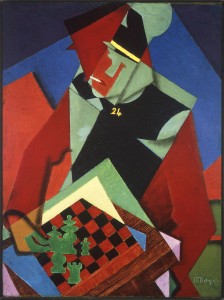
Jean Metzinger, ca. 1915-16, Soldat jouant aux échecs (Soldier at a Game of Chess, Le Soldat à la partie d’échecs), oil on canvas, 81.3 x 61 cm, Smart Museum of Art, University of Chicago
A significant modification of Cubism between 1914 and 1916 was signaled by a shift towards a strong emphasis on large overlapping geometric planes and flat surface activity. This grouping of styles of painting and sculpture, especially significant between 1917 and 1920, was practiced by several artists; particularly those under contract with the art dealer and collector Léonce Rosenberg.
The tightening of the compositions, the clarity and sense of order reflected in these works, led to its being referred to by the critic Maurice Raynal (fr) as ‘crystal’ Cubism. Considerations manifested by Cubists prior to the outset of World War I—such as the fourth dimension, dynamism of modern life, the occult, and Henri Bergson’s concept of duration—had now been vacated, replaced by a purely formal frame of reference.
Crystal Cubism, and its associative rappel à l’ordre, has been linked with an inclination—by those who served the armed forces and by those who remained in the civilian sector—to escape the realities of the Great War, both during and directly following the conflict. The purifying of Cubism from 1914 through the mid-1920s, with its cohesive unity and voluntary constraints, has been linked to a much broader ideological transformation towards conservatism in both French society and French culture.
Cubism after 1918
The most innovative period of Cubism was before 1914. After World War I, with the support given by the dealer Léonce Rosenberg, Cubism returned as a central issue for artists, and continued as such until the mid-1920s when its avant-garde status was rendered questionable by the emergence of geometric abstraction and Surrealism in Paris. Many Cubists, including Picasso, Braque, Gris, Léger, Gleizes, and Metzinger, while developing other styles, returned periodically to Cubism, even well after 1925. Cubism reemerged during the 1920s and the 1930s in the work of the American Stuart Davis and the Englishman Ben Nicholson. In France, however, Cubism experienced a decline beginning in about 1925. Léonce Rosenberg exhibited not only the artists stranded by Kahnweiler’s exile but others including Laurens, Lipchitz, Metzinger, Gleizes, Csaky, Herbin and Severini. In 1918 Rosenberg presented a series of Cubist exhibitions at his Galerie de l’Effort Moderne in Paris. Attempts were made by Louis Vauxcelles to claim that Cubism was dead, but these exhibitions, along with a well-organized Cubist show at the 1920 Salon des Indépendants and a revival of the Salon de la Section d’Or in the same year, demonstrated it was still alive.
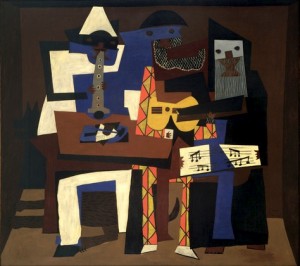
Pablo Picasso, Three Musicians (1921), Museum of Modern Art. Three Musicians is a classic example of Synthetic cubism
The reemergence of Cubism coincided with the appearance from about 1917–24 of a coherent body of theoretical writing by Pierre Reverdy, Maurice Raynal and Daniel-Henry Kahnweiler and, among the artists, by Gris, Léger and Gleizes. The occasional return to classicism—figurative work either exclusively or alongside Cubist work—experienced by many artists during this period (called Neoclassicism) has been linked to the tendency to evade the realities of the war and also to the cultural dominance of a classical or Latin image of France during and immediately following the war. Cubism after 1918 can be seen as part of a wide ideological shift towards conservatism in both French society and culture. Yet, Cubism itself remained evolutionary both within the oeuvre of individual artists, such as Gris and Metzinger, and across the work of artists as different from each other as Braque, Léger and Gleizes. Cubism as a publicly debated movement became relatively unified and open to definition. Its theoretical purity made it a gauge against which such diverse tendencies as Realism or Naturalism, Dada, Surrealism and abstraction could be compared.

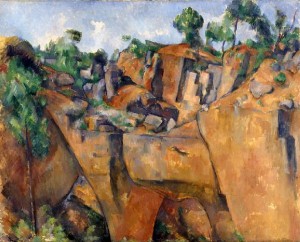
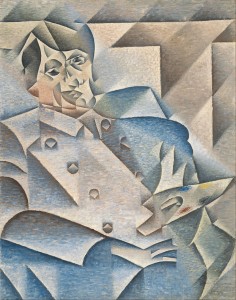
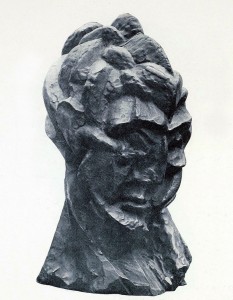



Leave a Reply
You must be logged in to post a comment.